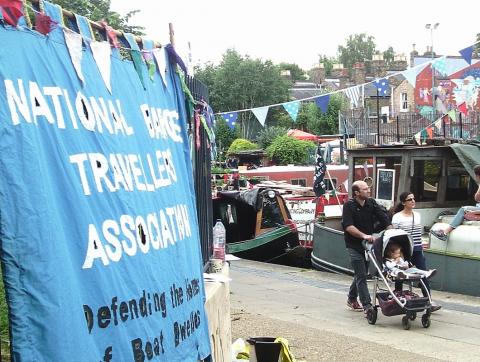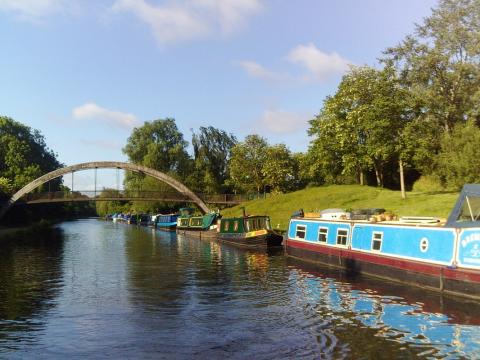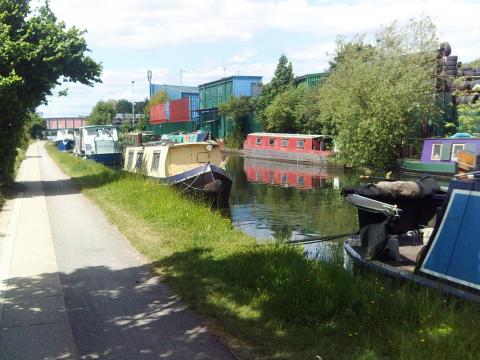Boater's Appeal Court victory on Human Rights
March 2017 - Peter Underwood looks at an unprecedented Appeal Court victory which says the human rights of boaters must be taken into account by C&RT.
An Appeal Court decision may put the brakes on the Canal & River Trust's attempts to make life increasingly difficult for continuously cruising live-aboard boaters.
It's ruling that Matthew Jones can use part of the Human Rights Act - the right to respect for his home - as defence against C&RT's attempts to remove his boat under a Section 8 action, throws out the Trust's oft repeated claim that it can't be treated as a housing authority.
The Terms and Conditions imposed on boaters by the Canal & River Trust, especially those related to making a 'continuous journey' are likely to become much more likely to be challenged successfully if Matthew Jones now wins his case when it returns to the lower court.
The Community Law Partnership, which took the case to appeal says that Matthew Jones who has been living aboard his boat 'Mrs T', for six years was challenging the lower court's refusal to consider his 'Article 8' human rights as well as challenging the lawfullness of ‘continuous cruising guidance’.
It says: “In 2014 CRT asked for an order dismissing summarily the Appellant’s Article 8 part of his defence. ... The county court judge struck out the Article 8 part of the Appellant’s defence and a high court judge dismissed his appeal. He appealed to the Court of Appeal.”
In the Court of Appeal Lord Justice McCombe stated: “….In my view… the burden of dealing with an Article 8 defence is one that will from time to time, however, have to be shouldered by the court in assessing a defendant’s personal circumstances and in the balancing exercise in weighing those circumstances against the “given” represented by the Respondent’s aims in the proceedings.
“I have made suggestions as to areas in which summary disposal of such defences may be possible. However, I do not consider that the judge was correct in identifying the “burden” of dealing with Article 8 defences as a reason for striking them out summarily.”
The Community Law Partnership says: “This is an extremely important judgement for boat-dwellers. If they raise an arguable Article defence (e.g. due to health problems, need to be near work, needs of children etc) then that should be dealt with at the trial of the matter and not summarily dismissed.”
The Bristol Post reports that Matthew Jones who has been living aboard his boat 'Mrs T', for six years, was hit by a crackdown by the Trust on Ccers – leading to a Section 8 and the Trust seeking injunctions against him, forbidding him from using a boat on any of the waterways it manages.
In the past C&RT has avoided ending up in the Appeal Court, fearing precedents would be set but, in a case that broke new legal ground, three Appeal Court judges in London have overturned the county court decision.
The case will now return to the county court for a full hearing.
If that is successful, now that it is clear human rights apply to CC boaters it will put into serious question the approach and attitudes of C&RT enforcement, which have been getting steadily more dictatorial.
It will certainly bring into question parts of the approach spelled out by London Enforcement Manager Simon Cadek and sent to a boater who was warned that they were on course for failing their six month restricted licence, telling them what they would need to do to pass.
The email is on public record as part of advice to boaters in the London Boaters Facebook group and dates from the end of 2016.
“When we are looking at boat movements we are looking for characteristics of bona fide navigation, these fall roughly into four categories:
· Range: by range we mean the furthest points a boat has travelled on the network, not merely the total distance travelled. While the BW act does not stipulate what that distance is the Trust has previously said that anyone travelling a range of less than say 20 miles (32km) would struggle to satisfy the Trust that they are engaged in bona fide navigation and that normally we would expect a greater range.
. For the avoidance of doubt, a small number of long journeys over a short period of time, followed or preceded by cruising in a small are of the network would not generally satisfy the Trust that you are engaged in bona fide navigation.
· Overstaying: we look to see how often boats overstay, either the 14 day limit on the main length of the canal, or shorter periods where local signage dictates, for example short stay visitor moorings.
While we are flexible with the occasional overstay from most boaters due to breakdown, illness or other emergencies, we will look at the overall pattern balanced with range and movement pattern in order to form a view.
Overstay reminders are issued when a boat is seen in the same area for more than 14 days. While we are unable to say how far you need to travel each time you move, we would advise that you normally travel further than a few km each time.
This will prevent you from getting reminders and depending on the length of other trips you make and how many times you turn back on yourself, should increase your overall range over the course of your licence.
· Movement: Continuous Cruiser Licences are intended for bona fide (genuine) navigation around the network, rather than for a boat to remain in one mooring spot, place neighbourhood or area.
We would expect boats on these licences to move around the network such that they don’t gravitate back to favoured areas too often i.e. in a way that it’s clear to us that they’re living in a small area of the waterway.
The basic principle of this is that these licences are not intended for living in an area and if it looks like a boat is habitually returning to a particular part of the waterway then this would not generally satisfy the Trust.
Within an acceptable range we’d expect a genuine movement, so for example it would not satisfy the Trust if a boat went on a 60 mile trip during the course of say two weeks, then returned to cruise in an area of say 5 miles the remainder of the time (figures are examples only).
Generally speaking, the smaller the range the less we’d expect to see boats back at the same locations. Of course people need to turn around and they’re perfectly free to re-visit places they have been to before, it’s living in a small area on this kind of licence that would cause a problem. "
The Floater asked Canal and River Trust for a statement on how the Appeal Court judgement would affect it's approach to enforcement but, at the time of publishing, no response had been received.
We will bring you up to date when we have a response.
The Appeal Coiurt verdict will certainly be welcomed at the national Boats Are Homes demonstration being staged in London on Saturday 8th April.
The march will demand that Canal & River Trust stops evicting or threatening to evict boaters without home moorings based on their distance or pattern of travel.
The National Bargee Travellers Association, which is organising the protest says the right to use and live on a boat without a home mooring on C&RT waterways is enshrined in the British Waterways Act 1995.
It argues C&RT's 'rules' are not supported by the law, which does not state a minimum distance that must be travelled to prevent CRT seizing your home.
Those wanting to join the protest assemble at 12 noon at Victoria Embankment Gardens, Villiers St, London WC2N 6NS for a march to Downing Street and on to DEFRA in Smith Square.
There's a Facebook event page: https://facebook.com/events/608556772678442
In 2016 boaters handed a petition to Number 10 Downing Street, signed by almost 30,000 people, opposing what NBTA describes as “C&RT's punitive and unlawful 'rules'”. Perhaps predictably, the Prime Minister passed the petition to DEFRA which in turn referred it back to C&RT, which refuses to change its policy.
Allan Richards looks at how C&RT ended up in the Appeal Court here: How C&RT lost in the Appeal Court
Photos: (1st) The National Bargee Travellers Association plan another Downing Street protest in April, (2nd) Boats are now spread across more of London's western waterways but the question for CCers is still whether they've travelled far enough, (3rd) Space isn't as unavailable as some would have you believe but still C&RT attempt to tighten the screw on CCers in London.








